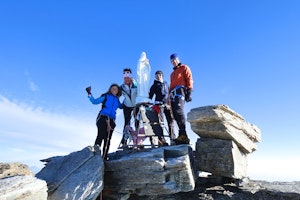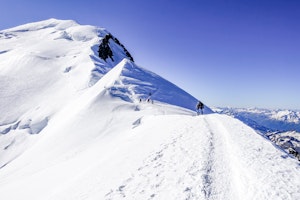Bouldering is the simplest form of rock climbing, where one has to climb short but difficult “problems” while focusing less on endurance and more on technique and power. Since height is in general not that big, you won’t need a rope or harness as you do with sport or trad climbing, where you reach bigger heights, have to secure yourself to the wall and also need a partner to keep you safe. For bouldering you secure your landing with pads, and you can go at it alone. This makes bouldering a great way to kickstart your rock climbing.
Bouldering can be practiced outdoor on big boulders or in indoor bouldering gyms. Since you don’t need a partner, it is easier to get started with bouldering than sport climbing. Also, there is no safety systems or knots you have to learn so you can jump straight into climbing and worry about that later. Regardless, it is one of the most social disciplines of climbing: because the problems are short, there is a lot of time to chat and exchange beta on the ground.
What is so awesome about bouldering?
‘Bouldering gives me the opportunity to climb in beautiful places with no heavy equipment to carry and less pressure related to safety issues’.-
Kivik François, professional climber.
 bouldering in Posettes Chamonix
bouldering in Posettes Chamonix
Bouldering in Aiguilles des Posettes, Chamonix. Photo courtesy of Kivik François.
‘Practicing bouldering is doing rock climbing in a very playful way and at the same time, it’s a mean to improve your climbing moves, your physical and mental capacities’.-
Ivan Houppertz, rock climber guide in Fontainebleau
For Carlos Vidal Arque, an AEMG guide from Spain with a passion for all rock climbing disciplines, these are the best three things about bouldering:
1) It’s social!
‘Bouldering is a social and independent activity; you can enjoy a lot of time interacting with your friends and you can rest alone if you are tired. You can share more betas and talk about the climbs on the ground. No mater the climbing grade, you can go bouldering with a squat with huge level difference without needing technical knowledge to belay. You just need a crash pad and two arms to take care about your partners safety’.
2) You get a lot of training
‘I just love climbing. When you practice different types of rock climbing you enhance your skills because of the transversal interactions. In bouldering, I train a lot on strength and very specific tricky moves skills that give me something extra for the routes, multipitch or deep-water soloing (dws) climbs. It’s a good and fast training, but you can get very tired in a couple of hours. The relation between resting time and activity time is high; you don’t need to belay 40 minutes to your partner and you can manage better your timing’.
3) It has a creative side
‘I like to open new lines, clean and brush the rock, read what nature gives us to hang and climb, discover the choreography quiz to reach the (mini) summit: that’s the creative side of bouldering climbing. You can get surprised by a funny and funky new beta or moves you can’t imagine on other forms of climbing. In other rock climbing disciplines you need a lot of effort and logistics to bolt a new route or open a new dws line’.
Difficulty grades
 Bouldering in Aiguilles des Posettes, Chamonix
Bouldering in Aiguilles des Posettes, Chamonix
Bouldering in Aiguilles des Posettes, Chamonix. Photo courtesy of Kivik François.
Bouldering problems’ difficulty can be assessed on 2 different scales. The Font scale predominates in Europe and Asia, while in the US, Australia and New Zealand you have the the V scale. These are the norm when it comes to rating outdoor bouldering. However, climbing gyms might have their own system such as different coloured routes for various difficulties.
Font scale
It was established well before the V scale and originates from the forest of Fontainebleau, in France. The open ended scale technically starts off at 1 and the higher the number, the more difficult the problem is. However, the vast majority of easy boulders are graded with a 3.
After the scale reaches grade 6, letters from A to C are added to better describe the difficulty. This means that a 6A is easier than a 6B, which in turn is easier than a 6C. A “+” can also be added after the letter, making an 6A+ problem harder than a 6A but easier than a 6B.
The scale uses capital letters in order to distinguish it from the sport climbing grading (6a vs 6A)
V scale
The V comes from the John Sherman’s nickname, “Vermin” or “Verm”. He was the creator of the V scale, which took birth in Texas, USA. Just as the Font scale, it is open ended. It starts at VB (B stands for Beginner) and continues using numbers: V0, V1, V2 and so on. Similar to the Font scale, it is open ended and the more difficult a problem is, the higher the grading number is.
A “+” or a “-” can be added after the grading making a V5 easier than a V5+ but harder than a V5-.
Types of bouldering
 Bouldering in Plan de l'Aiguille Chamonix
Bouldering in Plan de l'Aiguille Chamonix
Bouldering in Plan de l’Aiguille, Chamonix. Photo courtesy of Kivik François.
Typically a boulder ‘problem’ shouldn’t be higher than 4-5 meters but limits are vague. Bridging the gap between bouldering and sport climbing is the more extreme and risky highballing. This is basically bouldering at bigger heights that can reach up to 12 meters. The lines between this and free soloing, which means climbing high walls with no safety equipment, get even blurrier and are usually highly subjective.
What equipment do you need?
 Bouldering in Fontainebleau
Bouldering in Fontainebleau
Bouldering in Fontainebleau. Photo courtesy of Kivik François.
One of bouldering’s best assets is its simplicity. Unlike sport climbing where you also need a rope, harness and a belay device (used to secure the climber), all you need to start bouldering indoors is a pair of climbing shoes and a chalk bag since most of the gyms are covered with thick paddings. However, if you want to start bouldering on real rock, a crash pad will be needed as well.
When is the best season to practice it?
 Bouldering in Fontainebleau
Bouldering in Fontainebleau
Bouldering in Fontainebleau. Photo courtesy of Kivik François.
As with rock climbing, this is highly dependent on where you are located. It all boils down to weather conditions. During summer time, the rock might be too hot to climb so a moderate temperature is preferred. What tends to ruin a day out at the crag is rain as everything gets slippery.
The good news is, if the weather is not good, you can always go and train at an indoor gym and improve your skills for when you are able to go outside.
Top spots to practice bouldering
 Bouldering in Fontainebleau
Bouldering in Fontainebleau
Fontainebleau, a great bouldering destination close to Paris. Photo courtesy of Kivik François.
1| Fontainebleau, France. The rock is a dark grey sandstone. Problems range from very easy to extremely hard. There is a huge amount of problems and they are marked with different colors for different circuits. Don’t miss our guide about Bouldering in Fontainebleau, an amazing destination at only 1 hour from Paris.
2| Ticino, Switzerland. Ticino is 1.5 hours away from Milan and features gneiss rock with mostly difficult problems. However, while there, you can also find a lot of cool moderate boulders.
3| Bishop, California, USA. Here you’ll find massive eggs of granite scattered around. There are problems for all levels and some of the best are of moderate difficulty. Boulders can get as tall as 15 meters, bordering free solo.
4| Rocklands, South Africa. Rocklands is located 3 hours away from Cape Town and is basically in the middle of nowhere. The sandstone boulders offer mostly easy and moderate problems, but you can also find some real challenges.
 Bouldering in Bishop USA
Bouldering in Bishop USA
Bouldering in Bishop (USA). Photo courtesy of Kivik François.
5| Ozark Mountains, Arkansas, USA. Located around the Horseshoe Canyon Ranch in Northwest Arkansas, this location offers problems ranging from very easy to very hard on very good sandstone rock.
6| Yosemite Valley, California, USA. One of the best granite destinations in the world, located 3.5 hours away from San Francisco. Considered the US climbing mecca.
7| Squamish, British Columbia, Canada. An hour away from Vancouver, Squamish is suitable for everyone as you can find granite problems going from V0 to V14.
8| Joshua Tree, California, USA. Located 3 hours away from Los Angeles, Joshua Tree offers bouldering problems for all levels. Beware, however, that problems might be underrated and therefore more difficult than they seem. It might also be difficult to find a camping spot.
9| Hueco Tanks, Texas, USA. It is situated 40 minutes away from El Paso, Texas. You can find a lot of roof climbing and overhangs on granite-like rock. To get in, you will need to call Texas State Parks in order to make a reservation.
 Bouldering in Fontainebleau
Bouldering in Fontainebleau
Bouldering in Fontainebleau. Photo courtesy of Kivik François.
Do you want to try it out yourself? Book one of our bouldering trips or indoor courses! Here are some ideas to get you started:
Indoor bouldering
Outdoor bouldering







